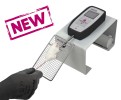Authors
AL Li, JD Crystal, YY Lai et al
Lab
Department of Psychological and Brain Sciences, Indiana University, Bloomington, IN, USA.
Journal
Neurobiology of Pain
Abstract
Childhood acute lymphoblastic leukemia (ALL) is a significant clinical problem that can be effectively treated with vincristine, a vinca alkaloid-based chemotherapeutic agent. However, nearly all children receiving vincristine treatment develop vincristine-induced peripheral neuropathy (VIPN). The impact of adolescent vincristine treatment across the lifespan remains poorly understood. We, consequently, developed an adolescent rodent model of VIPN which can be utilized to study possible long term consequences of vincristine treatment in the developing rat. We also evaluated the therapeutic efficacy of voluntary exercise and potential impact of obesity as a genetic risk factor in this model on the development and maintenance of VIPN. Out of all the dosing regimens we evaluated, the most potent VIPN was produced by fifteen consecutive daily intraperitoneal (i.p.) vincristine injections at 100 microg/kg/day, throughout the critical period of adolescence from postnatal day 35 to 49. With this treatment, vincristine-treated animals developed hypersensitivity to mechanical and cold stimulation of the plantar hind paw surface, which outlasted the period of vincristine treatment and resolved within two weeks following the cessation of vincristine injection. By contrast, impairment in grip strength gain was delayed by vincristine treatment, emerging shortly following the termination of vincristine dosing, and persisted into early adulthood without diminishing. Interestingly, voluntary wheel running exercise prevented the development of vincristine-induced hypersensitivities to mechanical and cold stimulation. However, Zucker fa/fa obese animals did not exhibit higher risk of developing VIPN compared to lean rats. Our studies identify sensory and motor impairments produced by vincristine in adolescent animals and support the therapeutic efficacy of voluntary exercise for suppressing VIPN in developing rats.
BIOSEB Instruments Used:
Grip strength test (BIO-GS3)

 Pain - Thermal Allodynia / Hyperalgesia
Pain - Thermal Allodynia / Hyperalgesia Pain - Spontaneous Pain - Postural Deficit
Pain - Spontaneous Pain - Postural Deficit Pain - Mechanical Allodynia / Hyperalgesia
Pain - Mechanical Allodynia / Hyperalgesia Learning/Memory - Attention - Addiction
Learning/Memory - Attention - Addiction Physiology & Respiratory Research
Physiology & Respiratory Research
 Pain
Pain Central Nervous System (CNS)
Central Nervous System (CNS) Neurodegeneration
Neurodegeneration Sensory system
Sensory system Motor control
Motor control Mood Disorders
Mood Disorders Other disorders
Other disorders Muscular system
Muscular system Joints
Joints Metabolism
Metabolism Cross-disciplinary subjects
Cross-disciplinary subjects Preclinical studies and opioids: role in crisis management in the United States
Preclinical studies and opioids: role in crisis management in the United States 